1. Introduction
When I was making pictures with my brand new D800, I found out I got quite some mis-focused pictures compared to my other DSLR cameras (D70, D300, D700 and D7000). After a short investigation, and confirmed by reports on the web, it turns out that there are autofocus problems with the left field autofocus points with samples of the Nikon D800 and Nikon D4. In this post I’ll summarize my own experiences, and try to keep up with the latest insights in how Nikon will resolve the issue.
2. Observations
Simply put, if you make a picture using the optical viewfinder AND one of the left field focus points, the resulting picture is unsharp. The problem does not occur with any of the mid or right field focus points or when using live view for any of the focus points. The problem becomes better visible with wide-angle (<= 50mm) lenses, and when the object is at larger distances of a subject (> 1m).
I’ve made the problem visible by making several pictures of a bookshelf (made with a 24-70/2.8, in this specific case@24mm@f2.8 at about 1.4m distance, manual mode, 1/160, f2.8, autoISO, autoWB, JPG straight out of the camera). For these pictures the camera is fixed on a tripod at the same location, and only the AF point is changed. To get an idea where the middle, left-most and right-most focus points are situated, a full overview picture is shown below.

The following excerpts show a 100% crop from the above picture showing the sharpness achieved for different auto focus points:
MIDDLE auto focus point:

LEFTMOST (left_5) auto focus point:
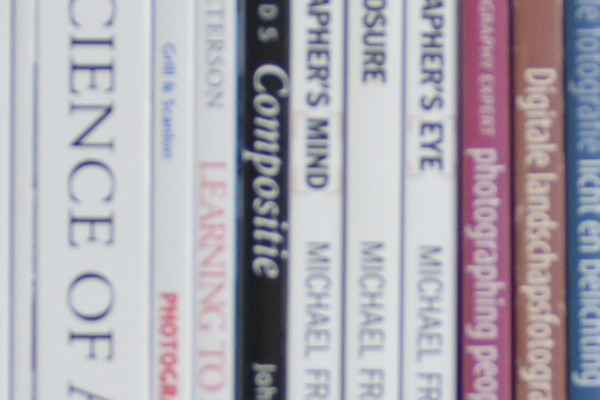
RIGHTMOST (right_5) auto focus point:

To give an idea how the sharpness changes when you move the focus point from left to right, see the assembled picture below. I’ve indicated the position of the focus point with the red text, where number 5 is the focus point furthest away from the centre focus point. As you can see from the picture, the sharpness remains constant going from the middle to the right focus point, but gets worse when going further from the middle to the left (small differences in color temperature and brightness are because autoISO and autoWB were enabled; not relevant for the test).

To exclude focus problems with the setting I’ve created, I’ve taken many different pictures by for instance turning the camera upside down (i.e. exchange the focus points), use different type of subjects, but unsharp pictures occur consistently when a left-field auto-focus points is chosen.
When selecting the left-most focus point, and comparing it a picture made with live view selecting the same focus point (which for live view is typically somewhat larger!), you can clearly see that the live view picture has the expected sharpness, whereas the viewfinder based picture is unsharp at the point of focus.
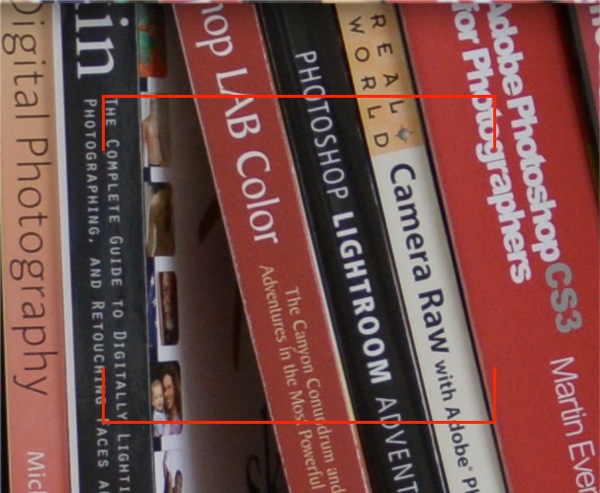
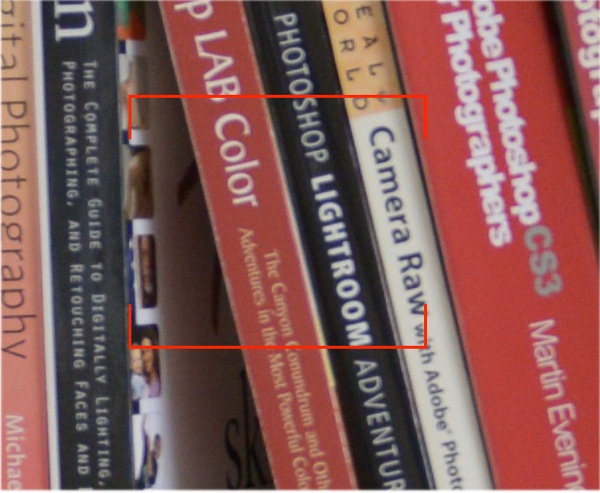
The left field AF points tend to focus to objects further away. The following two excerpts show a part of the bookshelf with a book stored in the back (bookshelf about 50cm deep, camera about 2m away from the bookshelf). For the middle to right focus points this book looks blurry, for the left-most AF point the text on this book looks pretty sharp, whereas the part that should be in focus looks blurry.


This clearly points towards a problem with the focusing system on the left side using viewfinder-based autofocus.
3. Analysis
A. Contrast versus phase autofocus
The focus problem only reveals itself when using the optical viewfinder. Good and consistent results are accomplished using live view.
Live view uses contrast detection auto-focus (CDAF). CDAF is based on the sensor directly, and is very precise. The disadvantage is that it is slow (not considering some latest innovations in the latest mirror less cameras), as all the data needs to be extracted from huge mega-pixel sensors.
The optical viewfinder uses phase detection auto-focus (PDAF). PDAF uses a dedicated mechanism based on mirrors and a separate module (the CAM3500FX) to accomplish auto focus faster. It should however be optically aligned with the sensor, hence the assembly plus calibration of such a device is very important to obtain similar results as with CDAF.

For more info see http://en.wikipedia.org/wiki/Autofocus, or even more details in Google Books, this article of Douglas Kerr, this extensive French wiki, a Korean article and French article with many nice pictures, and LensRental.
Conclusion: the problem only occurs when focusing via the viewfinder. Live view results show that the trajectory from object to lens to sensor is fine, so we don’t have to question the test setup. The focus problems can be narrowed down to viewfinder focus.
B. Lens
One hypothesis could be that the problem is lens-related. This is not the case because of the following reasons.
1. All my lenses focus correctly at all focus points when live view is used.
2. The problem occurs with multiple lenses (14-24mm/2.8, 50mm/1.4G, 24-70/2.8, 70-200/2.8).
3. It would be highly unlikely that all of these lenses exhibit a problem only on the left side, and only on this camera.
Conclusion: The problem is not lens related.
C. AF fine tuning
Although the lens may not be the problem, optical variations may cause different behavior when using PDAF compared to CDAF. PDAF relies on a different optical path with different components to accomplish focus. If this path is not aligned and/or calibrated to the direct path from lens to sensor, it may calculate a wrong focus distance.
Nikon offers a possibility to fine-tune this difference for each lens-camera combination. One can optimize the sharpness results by shifting the point of sharpness forward of backward. See Nikon’s recommendations on how (and when!) to do this. Because AF-fine tuning is applied by the same amount to all focus points, it is not possible to calibrate each focus point independently using the camera menus. Hence a focus mismatch in one region of the field cannot be solved by changing the AF-fine tuning.
None of my lenses require AF-tuning to accomplish good or decent sharpness for the middle and right focus points (checked with a Spyder lenscal and double checked with other objects).
Conclusion: The AF focus problem is not related and cannot be solved by AF fine-tuning.
D. Focus shift
When focusing using the viewfinder, the camera focuses with the largest aperture (lowest figure), and makes a picture with the selected aperture. E.g., in case of a f1.4 lens set at f2.8, the system focuses at 1.4, but makes the picture with 2.8. When using live view, the camera would use an aperture of 2.8 for the focusing.
Light sensitive lenses (with an aperture of 1.4 to say 2.8) have a property called focus shift. This means that if you focus using a particular aperture, and you change the aperture without changing the focus, the point of sharpness changes (e.g. see dpreview). The reason for mentioning this, is that this may cause differences with live-view and viewfinder based pictures. This is important for AF fine tuning, but also to diagnose the characteristics of the D800 focus problem properly (e.g. is it always front or back focusing?) .
Although focus hunting may result in some inconsistent reporting, the D800 focus problem is not related to focus hunting. The focus results for the left and right point are different, where the left is unsharper.
Conclusion: Always test sharpness with the largest aperture of a lens to avoid focus hunting.
E. Field curvature
Some people mention field curvature as a potential problem. Field curvature is the effect that lenses tend to bend the image, hence a flat object in real life is not project completely flat on a sensor. This is expressed by the picture below. When you set your focus point to the middle, then the edges will become unsharp. If you would focus on the edges, the middle of the image becomes unsharp. Especially wide-angle lenses do have some (intrinsic) field curvature.
When a lens that requires some AF-fine tuning is not fine-tuned, the effect of field curvature can be magnified in the outer focus points. Where the middle point is just about sharp, the edges become quite unsharp. By AF-tuning the lens, the sharpness results can be improved overall. Nevertheless, fine-tuning the PDAF system to the CDAF system based on the centre focus point, and expecting ultimate sharpness for all possible use-cases (lens focal length, lens aperture, object distance, focus points) is virtually impossible. Hence some slight deviations in sharpness are to be expected and normal.

Although some reported tests on the web can be related to field curvature, the focus problem of the D800 is not related to field curvature. There are multiple reasons for that:
1. It would have the same effect when selecting a right focus point, which is not the case.
2. The whole picture is unsharp when using the left focus point
3. The outer focus points for full-frame cameras are not situated at the boundaries of a lens, but between the middle and the boundary of a lens (at 25% and 75%). Lens tests (e.g. 24mm/1.4 or 24-70/2.8) show that at those positions the lens is almost as sharp as in the centre.
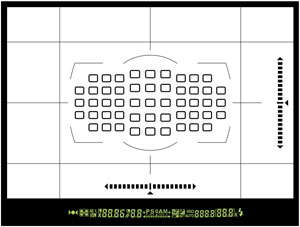

Conclusion: Field curvature is not the cause for the unsharpness reported as the left-field AF problem.
F. Focus distance and focal length
It seems that the focus problem is more obvious with wide angle lenses at larger distances from a subject. With my 85mm/1.4 at short distances, hardly any effect can be seen when selecting different focus points. Some people report good results with a 85mm/1.4G only, and claim their camera is OK, which is not a guarantee.
I see focus problem with the 14-24/2.8, the 24-70/2.8 and the 50/1.4, and not or hardly with the 60/2.8 and 85/1.4 (although others report there is). I haven’t tested my other lenses yet (and I don’t intend to).
Conclusion: The focus problem does not become obvious with every lens.
G. Difference in focus points
The middle focus points are so-called cross-type focus points that are more (light)sensitive and accurate (detect both vertical and horizontal lines) than the other AF points. Some claimthat the AF problems are related to AF problems due to the smaller accuracy of the outer focus points. This does not explain why the problems only occur on the left side of the focus field.

There have been reports that the problem only occurs when a single focus point is used. Therefore I’ve also tried multiple focus points, and other AF-modes (AF-S, AF-C), but the focus problems remain the same when only left-side focus points are used.
Conclusion: The AF problem is not related to focus modes or focus point differences.
H. Focus consistency
Auto focus is based on optical measurements, depending on optical, mechanical, electrical and mathematical principles. When focussing on a subject, small deviations may occur (see for instance this movie), and hence not every focus attempt will deliver guaranteed optimal sharpness. For that reason it makes sense to make multiple photos when testing AF performance.
Conclusion: Make multiple pictures when checking focus performance. Also try different angles and distances to see if this impacts the results.
I. Subject quality in terms of focus accuracy
Some objects are difficult to auto-focus. In general, CDAF gives better and more accurate results than PDAF. When testing a camera-lens setup, it is important to have good contrasty and/or texture rich subjects. When a camera has difficulties with auto focus, in most cases the lens start to hunt for focus (go hence and forth). In such a situation, focus results can be off. In case of the bookshelf I use for my tests, or a lenscal, I obtain consistent and good results. I also turned around the camera upside-down to exclude potential focus problems with books on one side. In each experiment the left-field AF points give me unsharp results, all other AF points give me sharp results.
Conclusion: The subject quality is sufficient to detect the auto focus problem with the D800.
J. High Resolution
Some say it is “logical” that a camera with so many pixels is more sensitive to sharpness. Although the claim is certainly true, sharp results can be accomplished with live view and the middle/right focus points, so resolution is not a problem here. Furthermore, the sharpness issues can seen very easily when looking at the results at say 25% zoom rate, which would equal a 2.25 MPix camera at 100% scale:


Conclusion: The AF problems are visible at lower resolution than the full 36MPix density, and are not related to the high pixel density of the D800 (or D4 which exhibits the same problem).
K. Camera movement
To avoid any movement during picture taking, the mirror up mode of release delay (e.g. see dpreview) should be used, and the camera should be on a tripod. Nevertheless, the AF problem is so significant that it can be easily shown when taking pictures out of the hand.
L. Other cameras
I’ve also performed the same tests using my D700, (based on the same CAM3500FX module for PDAF focusing), and it shows consistent behavior over all focus points. There is no substantial difference in sharpness.
M. Tilted assembly
One hypothesis is that the problem is caused by a tilted assembly of the CAM3500FX module, or one of the mirrors. This is quite hard to understand knowing that the right side focus points yield good results, and the focus principle is based on a symmetrical differential setup.
N. Firmware
Another hypothesis is that the problem is caused by a firmware error. This is hard to understand knowing there are cameras with no problem.
O. Calibration error
Another hypothesis is that the live view optical path is calibrated during manufacturing, and an erroneous procedure (or no procedure?) was in place in one of these plants. In that case, cameras need to be send back to Nikon Service for re-calibration when they have the right means in place.
4. Towards a solution
My camera has been fully repaired now. It took a couple of iterations, in close cooperation with Nikon Service Points the Netherlands to repair the camera. See the following posts here:
- First repair results
- Additional results after lens calibrations
- Overview of repair procedure applied
- Final repair results
Appendix – More info on the web
The left-field AF focus problem has been mentioned on the web already many times. Here is a list of some links.
- Ming Thein
- Lumolabs and Lumolabs interview with Nikon Germany, and an a test of the sensor array using Reikan’s FoCal software
- dpreview forums
- Julian Vrieselaar
Some other interesting stuff:
- AF-fine tuning tutorial by Marianne Oelund
- AF accuracy tests by LensRental
- Blurry viewfinder problem
For the die-hard, some patents:
- Focusing detection apparatus
- Camera and focal point detection apparatus
- Automatic focus control device having a plurality of focus detection areas
- Camera focus detection apparatus detecting focus conditions among multiple areas within a photographic scene
Appendix 2 – Dust
Unfortunately I also seem to have quite some dust on my sensor. I’ve tried to remove the dust using a dust blower (repeated a couple of times), I got rid of a few, got 2 in return, but most particles seem to be sticky and dot go away. I’ve changed lenses maybe about 4 or 5 times in a very controlled manner to avoid dust, so given the amount of dust and the stickiness I would expect them to be present out-of-the-box. Hence, sensor cleaning seems to be another reason to send in the camera for service!
Underneath you’ll find an overview picture, and two excerpts at 100%.
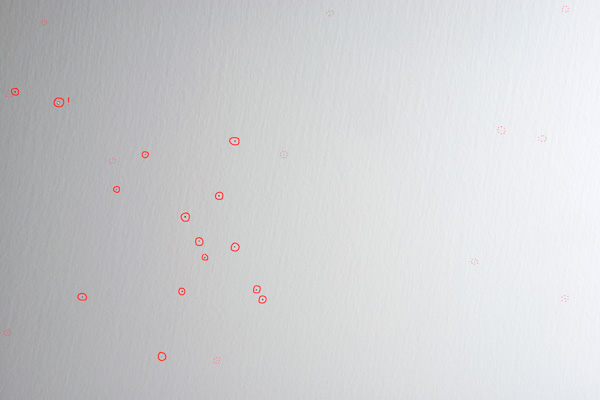


Best analysis I’ve seen to date. My first first D800 exhibited this behavior as does my D800E. Both are early production models.
Excellent article, very well written. Just a hint while you are waiting for Nikon to solve this. Set AF fine tuning such that the centre point is right at the front of the DOF, and then the left point will “just” come into focus at the back of the DOF on all lenses from 2.8 upwards. I found I was able to dial this in and get good focus at all focus points this way, except the 50mm at f1.4 (but its fine at f2.8). At f1.4, it is still a bit softer on the left side. So for now I have worked around this very clear defect. Some that say they do not have the problem, may well do, but certain lenses do not show it. An example is the 28-70 (predecessor to the 24-70), which has no issues at any focal length! Others may well not have the problem, and each camera is probably slightly different too. I also found that different copies of the same lens may exascerbate the problem. For example I have two 50mm F1.4G lenses, and on one the focus shift as you stop down the aperture is more severe than the other. This means using my fine tuning technique, it was still soft on the left side even at F4 or F5.6. Fortunately the second copy is much better for my “hack” until Nikon come up with a proper fix.
Hi Jonathan,
For the 24-70 lens applying an AF fine tune offset is no option. The lens quickly reveals visible chromatic aberration when it is slightly put out of focus. Furthermore, even with a setting of -20 I don’t get sharp pictures for the left-most AF point.
I prefer to use the centre focus point for the moment, and want for a fix. Either by means of a firmware update (if possible at all), or otherwise by sending in my camera to a Service Point, and let them recalibrate the focus points.
Excellent summary. I’ll be sending a link to your site to Nikon when I send my camera in for repair.
This seems the best analysis of similar problems i have been noticing… Camera went back to Nikon today and hope to get this resolved soon!
Under 4 you say: “Especially look at NL3, with photographs from the Dutch Nikon Service Centre, mentioning special SW for a fix”.
This is not correct. The software used was as far as I understood the software they normally use for calibrating autofocus; the software that was downloaded was the software needed for making adjustments in this specific camera (D800E).
addition: So the suggestion that Nikon made a fix that can be downloaded by the Nikon Service Centers – is not to be concluded from the post you refer to.
I understand the confusion. What I mean with “special software” is software that cannot be downloaded and used by consumers. It can only be used by people from the service centre. I understand the purpose of this software is to re-calibrate the focus points, and nothing more.
My D800E has the similar problem with 24-70 and 14-24. However, I found another problem in contrast detection AF of the live-view with AF-S Micro NIKKOR 60mm F2.8G. all focus goes fail and it is not concerned with position of focus points. In the case of Ai AF Nikkor 50mm F1.4D and phase detection AF, all focus goes fail on the left,center, and right focus point, not only left. Of course I don’t have any problem with my D700 and those lenses.
This is a great article. Very well documented. Nikon should put you on staff. Sure hope they fix it before I get mine. I ordered March 22 from B&H Photo. Still have no idea when it will be delivered. Maybe the wait will result in a fixed camera. Thanks for the article.
Nikon Australia are replacing my camera, I did not ask them to do that. This seems strange to me. Personally I would like them to fix the issue rather than give me another camera that could have the same issue. The fact that they are doing that confirms to me they don’t really think it can be fixed at this time. I just live in hope that I will get a good copy next time.
Fantastic article that explains totally exactly the issue I am having. Just wanted to ask mine hunts a lot more than my d3s to find focus in my studio have you found this as well?
No focus hunting on mine.
Just an update for you, I received my replacement D800 today and after some focus chart testing I can tell you that the new unit is perfect! Good to see that it looks like a ‘line issue’ on selected units, rather than a design flaw. Got to give thanks to Nikon for getting me this replacement with minimal fuss. I have it on good authority that this is affecting one in every two units sold here in Australia. First unit serial number was 8002xxxx this one is 8006xxxx if that helps anybody. Anyway my suggestion is to contact Nikon through your retailer and ask for a replacement. In my case it seems to have worked.
Good, that’s promising, given than in Australia the d800 price tag is higher.
Did Nikon cover the shipping expenses or you had to pay for those? May I ask if overall did you spend any money on getting this issue fixed?
Cheers
I spend like 15 euros to ship the camera insured.
Greetings everybody,
first I would like to thank the author for this very informative post.
A few hours before reading this article (among MANY, MANY others that are spread all over the web) I was pretty certain that it was more of my fault than the camera’s (a Nikon D4) and tried my best to detect where exactly have I done wrong.
After having a few more tests of my own, far less comprehensive than this one or some others’, I sadly reached the conclusion that my D4 has severe focusing problems, incredibly similar to the ones described here & everywhere else.
Having a shutter count less than 1000 (one thousand) frames, my Nikon D4 mostly back-focuses.
I accidentaly detected the faults looking at some images that I shot with Nikkor 85mm f/1.8D lens, used at f/2.8 & f/4 but I’m pretty certain it’s not aperture dependent.
I’ll have a second look at the rest of the images shot with other lenses but it’s already somehow irrelevant as the results that came from 85mm are quite…unpleasant for any camera, not a 6000 $ one.
Also, chronic behavior for my D800E, especially when used with Nikkor 24mm f/1.4, is already old news as it has been already reported by countless users.
More info everywhere on google and here :
http://www.nikonians.org/forums/dcboard.php?az=show_topic&forum=430&topic_id=7054&mesg_id=7054&page#7303
but specially here :
http://falklumo.blogspot.de/2012/05/d800-outer-sensors.html
http://www.falklumo.com/lumolabs/articles/D800Focus/OuterSensors.pdf
This isn’t by far something that should be ignored by Nikon as it is more than obvious for most of us who bought a camera enhanced with the new focusing system (Advanced MultiCam 3500FX) namely D800, D800E and D4 are plagued with smartphone qualities regarding focus acquisition.
The situation is most unfortunate on different levels, from both perspectives, besides the financial one (client side only).
I suppose it’s pretty clear that if Nikon chooses not to address the problem in an elegant manner, a Canon-like reputation awaits them (e.g. Canon 5D Mark II, a camera who’s out-of-focus mechanism is already an anti-brand name).
In the end let me just reiterate something that is usually missed out.
The error is system-dependent, hence the “fine-tune lens” camera option is NOT the correct way to address this issue.
The problem lies very deep and only profound changes to the camera (firmware update, service calibration designed specifically for this type of errors on these particular 3 cameras, replacement with a sample from a different/later batch etc..) can be of choice.
I (still) trust Nikon.
I also have it on both my D800 and my D800E i just got today. I was planning on selling my D800, to use the D800E to have a bit more sharpness. Don’t know what to do now…
I think i will sell my D800 anyways, so i have 1 camera, but i really need it for my holiday, so, don’t want to give it back…
Se my extensive testing today:
http://forums.dpreview.com/forums/readflat.asp?forum=1021&thread=41653613
Very informative and insightful. Now I have a sound idea of how to test my D800E. Thank you.
I’m using Nikon cameras for all my photography needs except android-photography, and Nikon has never failed me… …until yesterday. I was testing my new Nikon D800 yesterday. I didn’t intend to test the camera for issues, and was about to compare D800 and D3X frames taken at the same time. Something went wrong. Some pictures were good. VERY GOOD. And others were completely out of focus. I was freaking, doing test, after test, after test…
An finally I’ve figured out, that auto-focus is getting worse and worse as I move focus point to the left side of the frame. And that was the case…
I’ve got the camera with exactly the same problem that you have so thoroughly described. I’m eager to refer to your publication on my Facebook page. Thanks!
This is an incredibly detailed and comprehensive article. You compellingly argue the problem is real and the link collection on solutions is great. It still leaves me wondering what to do if I get a bad D800 unit – but at least I know exactly how to test for the autofocus defect.
Thanks for the links about a fix. I tested my D800 last night and it shows the problem. Lucky for me, there is a repair center in town and I hope to speak to someone in person when I drop off my camera.
Results of my testing can be seen here, in case anyone is interested.
http://photokaz.com/2012/07/nikon-d800-contrast-and-phase-detect-autofocus-testing/
Thanks very much for your thorough investigation and reporting of this problem. Yours is the most comprehensive of the numerous reports I have seen online about the D800 / D800E autofocus issues. I received D800E in June and recently tested mine in a manner like described in this posting. Indeed I found that I also have this issue. I contacted NikonUSA and strangely found that they did not seem to know about it. They asked for images and supporting information, which I supplied. I also included the link to this report. They have escalated my case to a supervisor, but three days later, I still have not heard anything!
Update:
About a week after my initial filing and escalating my case to management, NikonUSA asked me to send my camera back to Melville, NY for repair. They paid for the shipping and about 10 days later had my camera back to me after performing a calibration and firmware upgrade. I re-ran my experiment and indeed found that autofocus at the leftmost point works well. The rightmost one is fine also. However, the center point no longer works properly. I have not seen postings where this, or something similar has happened, but I am asking for Nikon to replace this unit with one free of this issue.
This is EXACTLY what normally happens on botched repair attempt. You pick up the camera, try the outermost point and think “yipee”. Then you try the centre and realise the problem has just shifted rather than being cured. Push for a replacement. You shouldn’t have to repair a brand new camera, and after a failed repair attempt, you certainly shouldn’t have to go through that pain again and again.
Update2:
NikonUSA asked for the camera back AGAIN. They would not honor my request for a replacement. This time they kept the camera for nearly 2 weeks in Mellville, NY. As a result, I missed a photo shoot (which they were made aware of well ahead of time). I got the camera back and it STILL has problems. Now it’s the bottom right focus points that do not work properly. So to summarize. First it was the left focus points that did not work. With repair #1 they fixed this, but then the center point did not work, then they fixed this and now I am seeing problems with the bottom right.
After giving Nikon two opportunities to get it right, I have insisted that Nikon replace my unit and stop holding my camera hostage while they tinker with it. There has been no response to this – but my only contact has been through the call center staff (whom I believe to be contractors). Despite repeated requests made by them, on my behalf, for someone from Nikon to contact me, there has been no such contact. I’m still waiting….
…and contemplating what my next steps should be.
I would seriously advise anyone who has had their camera’s autofocus repaired re-check all 51 points using careful techniques and controls such as those discussed in this posting.
Update 3:
After three repair attempts, the camera was returned to Melville. Once again, Nikon insisted on repairing it. They had it longer this time and assured me that the camera met all Nikon Specifications. Once I had the camera back, I re-tested it and, once again found issues. Of the nine points I tested, two produced what I would term soft focus – not tack sharp, but close. However, the Top Center point was really bad. Now it’s going back again, supposedly for replacement.
This issue scares me because I heavily depend on AF on my work. I sold my D700 early this year only to find out that D800 was not available right away. Then I bought 5dmk3 and I am quite happy with 61 AF points focus. After 7 months the unit is finally available. I was informed by local dealer to pick it up. Recognize this problem affected quite many units (random sampling), I decide to halt my purchase. I talked to my local dealer if there is a return policy if the unit I purchase turns out to be a defect. There isn’t such policy. Then I called Nikon service if they recognize this issue and if they have received some complains from other users, and they said they were not aware of it (what??!).
No guarantee. No formal statement from Nikon. I am not confident in purchasing this product. I don’t want to invest my money in defected product.
I write a comment when I appreciate a article on a site or
I have something to valuable to contribute to the conversation.
It is caused by the fire displayed in the post I read.
And after this post D800 autofocus problem | hifivoice.
I was actually excited enough to drop a thought 🙂 I actually do have a couple of questions for you if you tend not to mind.
Could it be simply me or do some of the comments appear like left by brain dead individuals?
😛 And, if you are writing on additional sites, I would
like to follow you. Could you list all of your shared sites like
your Facebook page, twitter feed, or linkedin profile?
People are free to conclude what they want based on the information that is at hand. I only object when people are twisting facts.
I keep my other pages for private/family use only.
The “dust” spots you show in this article may not be dust at all but rather oil splatters from the over-lubrication of the shutter mechanism direct from Nikon. About 1000 images into my new D800 I had the same issue. I am now at about 9,500 images and have cleaned my sensor three times. Another issue Nikon seems to be ignoring with their D800 cameras.
Wow, this post is nice, my younger sister is analyzing
such things, therefore I am going to let
know her.
A person necessarily assist to make severely articles I would state.
This is the very first time I frequented your website page and to this point?
I amazed with the analysis you made to create this actual
put up extraordinary. Wonderful job!
I would like to thank you for the efforts you have put in writing this blog.
I really hope to see the same high-grade blog posts from you later on as well.
In truth, your creative writing abilities has motivated me to get
my very own site now 😉
Thanks , I’ve just been looking for info approximately this subject for a while and yours is the greatest I have found out till now.
However, what concerning the conclusion? Are you certain in regards to the source?
At the end of your article you talk about dust. It is not dust at all you are seeing.(or at least very little of it is dust) What it is is oil splatters from Nikon’s “over-lubrication” of the shutter mechanism. These will continue to appear until about maybe 20,000 shots. Nikon will say to send it in and they will take care of it. While that maybe be true and last for about 500 more shots, the problem will re-occur over and over again. I can’t understand why Nikon will not fix this oh so obvious fix ! You will need to become a frequent sensor cleaner !
Not really.
It was cleaned after this first time, and didn’t reappear. I guess fr the D800 another story is valid than for the D600,
Thank you for any other informative site. Where else could
I get that kind of information written in such a perfect way?
I’ve a challenge that I am simply now running on, and I’ve been at the look out for such info.
Howdy! I could have sworn I’ve been to this site before but after browsing through some of the post I realized
it’s new to me. Anyhow, I’m definitely glad I found it
and I’ll be bookmarking and checking back often!
Hello there I am so delighted I found your blog, I
really found you by accident, while I was looking on Digg for something else, Nonetheless I am here now and
would just like to say cheers for a incredible post and a all round interesting blog (I also love the theme/design),
I don’t have time to read through it all at the moment but I have saved it and also added in your
RSS feeds, so when I have time I will be back to read a great deal more, Please do keep up
the awesome b.
Thx 🙂 It’s a long time I posted here, simply lack of time to spend to my hobby.
Wonderful, what a blog it is! This web site presents useful information to us, keep
it up.
This is a great article which describes exactly the same issue I noticed on my camera. Unfortunately for me, I purchased my D800 and 24-70 3 weeks before my wedding and honeymoon. After taking 5000+ photos mainly using the centre point to focus, I came back a really happy man and had no reason to question my camera. It was 18 months after that i noticed my camera had the issue after a group photography session with some fellow Nikonians.
After performing a series of tests, I figured out the issue in my camera was a very slightly mis-aligned AF unit or mirror exacerbated by backfocusing. To resolve it, i tried using AF Fine tune. Fortunately, an AF Fine tune setting of -11 sharpened all of the focus points from left to right for all focal lengths from 24mm to 70mm and focal distances from 3 meters out to close to infinity.
As the mis-alignment was only very very slight, I decided not to send my camera in as I did not have a problem shooting beautiful sharp pictures and I was very concerned Nikon would make things worse which I know would upset me no end. To this day, I am so glad I did not send it in and still love my camera despite it’s minor imperfection.